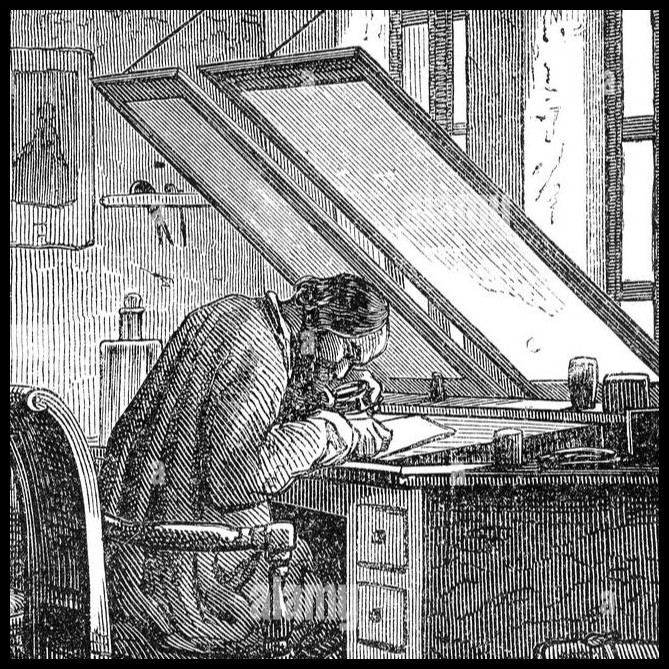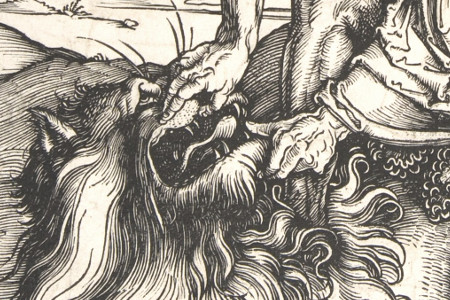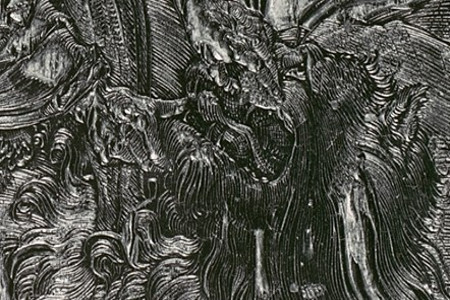|
Established 1967 Article No. 2 The Art of Engraving How did they do that? 19th Century American, "The Engraver at Work" (Detail) >>>
|
 |
Click any Image to Enlarge
|
Article No. 2
THE ART OF ENGRAVING Reverse, Backwards, and Inside-Out They are not alike... Steel engraving and wood engraving are not the same, aside from the material. Steel is an intaglio technique, wood is a relief technique. In other words, steel engraving is a technique whereby the printing ink is held and printed in small grooves incised under the surface of the engraving plate... while wood engraving is a "planographic" technique, whereby the ink is held and printed from the flat surface on top of a wood block. Steel engraving requires a press that can push the receiving paper into the finest of engraved lines under great pressure. Therefore 904 stainless steel is used so that the plate can withstand many impressions while maintaining the integrity of the image. Wood engraving presses work with much less pressure, thereby allowing a large number of runs often without ever breaking down. In fact, many wood engraving blocks from early Japanese printers are still in existance today and can produce high quality images nearly as fine as they did in the 18th and 19th centuries. In fact, newly offered vintage wood engravings are heavily scrutinized for specific characteristics that reveal their age (and therefore value). By definition, the method of steel engraving allows for smaller engraved lines and thereby greater detail derived from microscopic incisions. Wood engraving is a method allowing for greater freedon of expression and interpretation. Therefore, wood engraving has steadily become the method of choice for printmaking artists, beginning from the 4th century Chinese up to the modern era. Since then, etching (intaglio), linocutting (relief) and lithography, easier processes, have generally replaced most printmaking techniques for today's artists. Engraving is demanding... Of all the techniques used in print art, engraving, both in steel and wood, are the most demanding of artists for time, skill, and diligence. In 19th century America, engravers trained under a master for years before they were allowed to be considered an engraver. No degrees were awarded, no certificates given... just the word of a master and a sample of the artist's work were needed for consideration as an engraver. Masters were very demanding of their aprentices. Their own reputations were carried on by their students' hands. Reverse, backwards, and inside out... Both steel and wood engraving are done in mirror images, in order for the print to look like the artist intended. But wood engravers have an added challenge: that is to cut away what isn't there, or "inside out". If the wood (or lino) cutter wants to "draw" a line. he must cut away on both sides of the line, leaving the line standing on the surface, or "plane". It's like wearing your pants inside-out in order to make thme look rightside in. So the artist, in order to create a wood engraving, has to think in reverse while at the same time engrave inside-out. And if there is any text in his image, even a signature, he has to engrave it backwards. If there was ever any method of creating that is counter-intuitive, it wood engraving. Makes perfect sense, right? Well, not quite... There are many other technical aspects of both steel and wood engraving that had to be mastered. For steel ingraving, the preparation of the plate, toning of the plate (a whole nother topic), type of paper, knowledge of the characteristics of the inks, presses, engraving tools, even knowing how to sharpen them, all required experience and great skill. And of all the skills required to be consdered a master engraver, only the vision of the artist is intuitive... all the rest require diligent training and mental discipline. Thank you so much for reading this continuing artical... (Mr) Gayle B. Tate G. B. Tate & Sons Fine Art Fountain Inn, SC |
Coming Soon: Article No. 3 - American Artists and Engravers |


